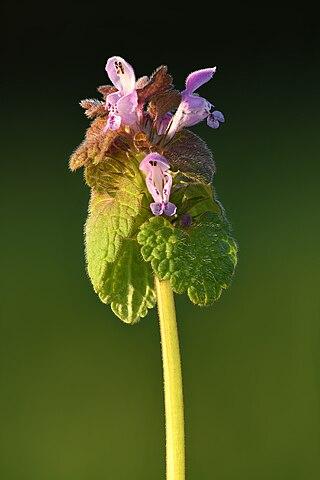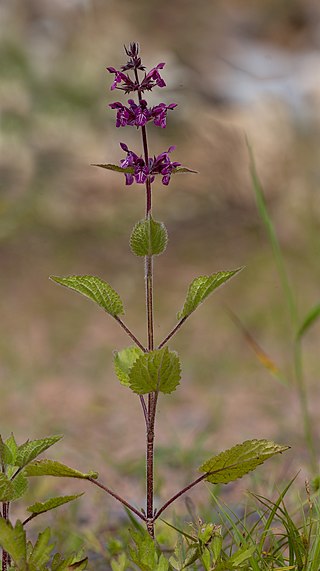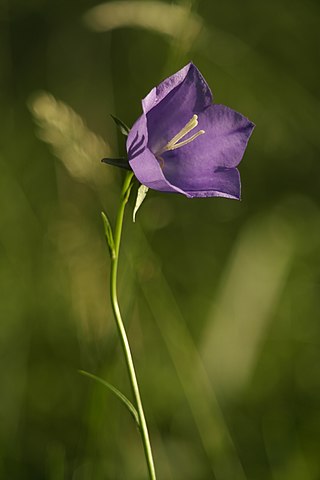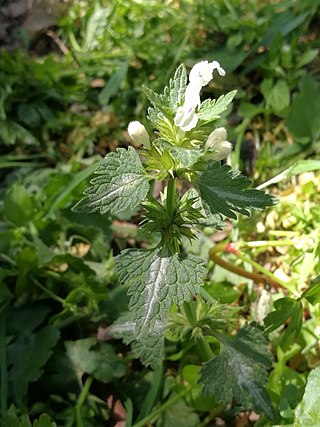
Lamium (dead-nettles) is a genus of about 30 species of flowering plants in the family Lamiaceae, of which it is the type genus. They are all herbaceous plants native to Europe, Asia, and northern Africa, but several have become very successful weeds of crop fields and are now widely naturalised across much of the temperate world.

Lamium purpureum, known as red dead-nettle, purple dead-nettle, or purple archangel, is an annual herbaceous flowering plant native to Europe and Asia but it can also be found in North America.

Lamium galeobdolon, the yellow archangel, is a species of flowering plant in the mint family Lamiaceae. It is native to Europe and western Asia but it is widely introduced in North America and elsewhere. It is the only species in the genus Lamium with yellow flowers. Another common name for this species is golden dead-nettle. In New Zealand, it is called the aluminium plant or artillery plant. The common names archangel and dead-nettle have been in use for hundreds of years, dating back to at least the 16th century.

Lamium amplexicaule, commonly known as henbit dead-nettle, is a species of Lamium native to most of Europe, Asia and northern Africa. Its status in Great Britain and Ireland is disputed; some sources give it as native, while others cite it as an archaeophyte. The specific name refers to the amplexicaul leaves.

Lamium album, commonly called white dead-nettle, is a flowering plant in the family Lamiaceae. It is native throughout Europe and Asia, growing in a variety of habitats from open grassland to woodland, generally on moist, fertile soils.

Galeopsis tetrahit, the common hemp-nettle or brittlestem hempnettle, is a flowering plant in the family Lamiaceae, native to Europe and northwestern Asia.

Salvia pratensis, the meadow clary or meadow sage, is a species of flowering plant in the family Lamiaceae, native to Europe, western Asia and northern Africa. The Latin specific epithet pratensis means "of meadows", referring to its preferred habitat. It also grows in scrub edges and woodland borders.

Lamium maculatum is a species of flowering plant in the family Lamiaceae, native throughout Europe and temperate Asia.

Stachys sylvatica, commonly known as hedge woundwort, whitespot, or sometimes as hedge nettle, is a perennial herbaceous plant growing to 80 cm (31 in) tall in woodland and unmanaged grassland. In temperate zones of the northern hemisphere it flowers in July and August. The flowers are purple. The leaves, when crushed or bruised, give off an unpleasant fetid smell.

Campanula persicifolia, the peach-leaved bellflower, is a flowering plant species in the family Campanulaceae. It is an herbaceous perennial growing to 1 m. Its flowers are cup-shaped and can be either lilac-blue or white. Its foliage is narrow and glossy with a bright green appearance.

Dominique Villars or Villar was an 18th-century French botanist.

Galeopsis bifida is an annual plant native to Europe and Asia but now found in Canada and the northeastern, midwestern parts of the United States. It has many common names such as bifid hemp-nettle, split-lip hemp-nettle, common hemp-nettle, and large-flowered hemp-nettle. The genus name means weasel-like, referring to the corolla of the flower. It is often confused with other species of Lamiaceae such as Mentha arvensis, Dracocephalum parviflorum and Stachys pilosa.

Salvia urticifolia is a herbaceous perennial native to the southeastern United States. S. urticifolia is an erect plant that reaches 20 to 70 cm tall. Flowers, with a corolla that is approximately 1.2 cm (0.47 in) long, are blue or purple, growing in panicles on short pedicels. The lower lip has three lobes, with a pair of white marks coming from the throat. The leaves are crenate—similar to the leaves of Urtica species.

Ranunculus trichophyllus, the threadleaf crowfoot, or thread-leaved water-crowfoot, is a plant species in the genus Ranunculus, native to Europe, Asia and North America.

Hexalobus crispiflorus is a species of plant in the family Annonaceae. It is native to Angola, Benin, Cameroon, Central African Republic, Congo, DR Congo, Gabon, Ghana, Guinea, Guinea-Bissau, Ivory Coast, Liberia, Nigeria, Senegal, Sierra Leone, Sudan, Togo and Zaire. Achille Richard, the French botanist who first formally described the species, named it after its wavy petals of its flowers.

Salix appendiculata is a plant from the willow genus (Salix). They can be found in France, Italy, Central and Eastern Europe, and on the Balkan Peninsula.

Galeopsis pubescens, also known as the hairy and downy hempnettle, is a herbaceous annual plant species in the family Lamiaceae, that can be found growing in various European countries.

Lamium bifidum is a species of flowering plant in the mint family Lamiaceae, native to the Southern Europe. It was first described by botanist Domenico Cirillo in 1788.



















